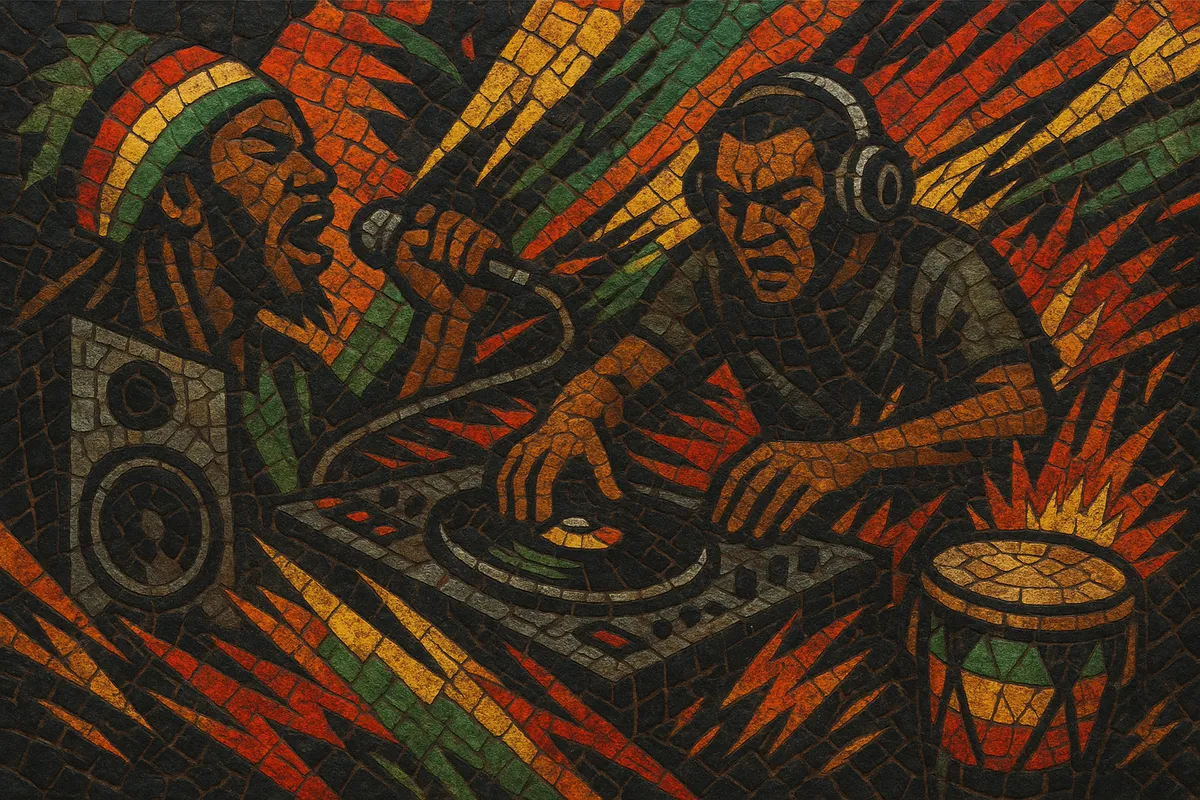Raggacore is a high-velocity fusion of breakcore and ragga/dancehall aesthetics that pushes the chopped Amen break and sub-bass idioms of jungle into harsher, more chaotic territory.
It typically features heavily processed breaks at 180–220 BPM, distorted kicks, rapid-fire edits, and Jamaican toasting or ragga vocal samples re-contextualized over maximalist, glitchy arrangements.
Where ragga jungle emphasizes rolling grooves and dubwise warmth, raggacore accentuates rupture, distortion, and shock, channeling rave energy into a punk-like, noise-splattered intensity.
Raggacore arose in the early 2000s from the European and transatlantic breakcore underground, drawing on the sample culture and rhythmic language of 1990s ragga jungle and drum and bass. Producers took the Amen-break chops, dubwise bass, and Jamaican toasting of ragga/dancehall and drove them through the distortion, glitch edits, and hyper-tempo ethos of breakcore.
Labels, promoters, and club nights in the Netherlands, the UK, France, Belgium, and Germany fostered a network where raggacore tracks circulated alongside hard-edged breakcore and mashcore. Artists such as Bong-Ra, Enduser, and Shitmat popularized the approach: ragga vocal snippets time-stretched and strafed over clipped, brickwalled breaks, terrorizing kick-drums, and quick-cut arrangement stutters. Dutch and UK events (and later broader EU festivals) helped consolidate the style’s identity distinct from ragga jungle: less rolling and dubby, more confrontational and break-driven.
Mid-to-late 2000s releases and tours gave raggacore peak visibility within breakcore circles. The style cross-pollinated with mashcore’s irreverent sample collages and with hardtek/tekno communities—helping seed raggatek, which applied ragga vox over pounding hardtek frameworks. Online forums, netlabels, and DIY distribution boosted the scene’s global footprint, from North America to Japan.
While remaining a niche, raggacore left a durable stamp on the breakcore ecosystem: it normalized the collision of ragga toasting with extreme rhythmic edits and distortion, influenced raggatek and mashcore hybrids, and reaffirmed breakcore’s ethos of recombining rave, jungle, and noise aesthetics into intensely kinetic forms.
• Aim for 180–220 BPM. Start with classic jungle breakbeats (Amen, Think) and accelerate them.
• Use aggressive swing via micro-edits and stutters to maintain forward momentum without losing danceability.
• Layer an Amen break with additional kicks/snares. Heavily saturate, overdrive, and clip the drum bus for character.
• Employ rapid chop-and-retrigger techniques, time-stretching, and glitch fills; vary break edits every 1–4 bars to avoid repetition.
• Design a dominant sub-bass (sine or reese) for the foundation; complement with distorted mid-bass for grit.
• Use bitcrushers, waveshaping, and tape-style saturation; automate filters and distortion amounts to shape phrases.
• Source ragga/dancehall toasting or a cappellas. Chop phrases rhythmically to punctuate transitions.
• Add classic dub FX (spring reverb, tape echo) but keep the overall mix hot and confrontational.
• Keep harmony sparse—short minor-key stabs, organ skanks, or dub chords work well. Focus on rhythm and energy.
• Arrange in high-contrast sections: quick intros, explosive drops, edit-heavy mid-sections, and abrupt breakdowns.
• For live/DJ sets, prep cue points for rapid cuts and doubles. Embrace abrupt transitions and teases.
• Mix loud and saturated but manage headroom with clipping-in-stages and tight low-end control (HPF non-bass elements).


